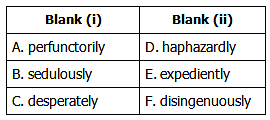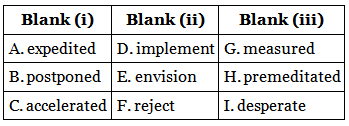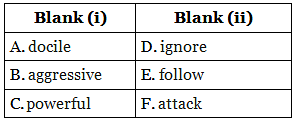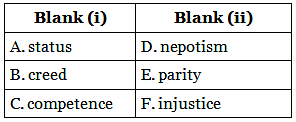Mock Test for GRE - 3 - GRE MCQ
30 Questions MCQ Test GRE Mock Test Series 2024 - Mock Test for GRE - 3
Directions: For each sentence, choose one word for each set of blanks. Select the word or words that best fit(s) the meaning of the sentence as a whole.
Q. A responsible business owner may easily feel ______ between her concern for the well-being of her employees and the challenges of financial shortfalls.
Directions: For each sentence, choose one word for each set of blanks. Select the word or words that best fit(s) the meaning of the sentence as a whole.
Q. The controversy surrounding the election dragged on for months, and the lack of a definite victor_____ governance and left people anxious about the future of their leadership.
| 1 Crore+ students have signed up on EduRev. Have you? Download the App |
Directions: For each sentence, choose one word for each set of blanks. Select the word or words that best fit(s) the meaning of the sentence as a whole.
Q. The busboy was known for his diligence rather than his celerity.
During his shifts, he worked (i) ________ when cleaning up after customers. Though the chef initially found it annoying, she came to appreciate having things done thoroughly rather than (ii) ________ .


Directions: For each sentence, choose one word for each set of blanks. Select the word or words that best fit(s) the meaning of the sentence as a whole.
Q. The middle school principal believed that even a minor (i) ________ the rules demanded his attention. Such a thing could not go (ii) ________ if he were to maintain discipline.
In his eyes, obedience and order were of the utmost importance.

Directions: For each sentence, choose one word for each set of blanks. Select the word or words that best fit(s) the meaning of the sentence as a whole.
Q. Ms. Barnhart, unlike previous executives at the engineering firm, eschews the practice of managing every aspect of the day-to-day activities of her team of managers. Instead, she (i) ________ based on the annual business plan. Ms. Barnhartbelieves that her approach avoids (ii) ________ team morale, which would inevitably and unfortunately occur under (iii) ________ management style.

Directions: For each sentence, choose one word for each set of blanks. Select the word or words that best fit(s) the meaning of the sentence as a whole.
Q. As a result of poor planning and disorganization, the young team (i) _____ attacking the root of the problem until there was little recourse left to them. They were obliged to (ii) _____ a (iii) _____ , last-minute solution to the problem.

Directions: Read the following passage and answer the question.
The Terracotta Army, 8,000 terracotta warrior figures guarding the tomb of the first Chinese emperor, Qin Shui Huang (259–210 ), was discovered in Xi’an in northwest China in 1974. The finding was remarkable not only for the sheer number of figures but for the intricate details of each sculpture. While it was a well-developed art form in ancient Greece, sculpture seems to have played only a minor role in ancient Asian art until the ascension of Qin Shui Huang. The variety of ear shapes, hairstyles, and armor among the figures has archaeologists pondering the possibility that the Terracotta Army may be representations of actual individual warriors. Such a level of detail is far beyond that of any known earlier Chinese sculptures.
Experts are searching for an explanation for this seemingly sudden appearance of sophisticated sculpture in ancient China. Recent DNA analysis of human remains found in westernmost China from the period of Qin Shui Huang yielded the surprising presence of European DNA, leading anthropologists to believe that Western contact with China may significantly predate the Silk Road, usually considered the inception of the relationship between these two civilizations. What is even more remarkable, however, is one of the responses to this discovery. Professor Lukas Nickel, an art historian from the University of Vienna, speculates that the presence of the DNA indicates that a Greek sculptor may have been employed at the site of the Terracotta Army to train the locals. Nickel also cites ancient Chinese records that reveal tales of giant statues appearing in the far West, as well as narratives stating that the emperor ordered the casting of copies in bronze that were erected in front of his palace. This account supports the notion of early contact between China and the West, which Nickel says could have inspired the First Emperor not only to duplicate the giant statues but also to build the huge Terracotta Army along with other life-size sculptures. Li Xiuzhen, a Chinese archaeologist specializing in the Terracotta Army, responds that the sculptures “may be inspired by Western culture, but were uniquely made by the Chinese.”
Nickel’s leap from the presence of European DNA in one part of China to his conclusion strains credulity. It is, at best, an interesting hypothesis demanding further evidence and, at worst, a pernicious example of Western cultural elitism wherein artistic developments that parallel or exceed those of Western culture are considered impossible without the impetus of Western influence.
Q. The primary purpose of the passage is to
Directions: Read the following passage and answer the question.
The Terracotta Army, 8,000 terracotta warrior figures guarding the tomb of the first Chinese emperor, Qin Shui Huang (259–210 ), was discovered in Xi’an in northwest China in 1974. The finding was remarkable not only for the sheer number of figures but for the intricate details of each sculpture. While it was a well-developed art form in ancient Greece, sculpture seems to have played only a minor role in ancient Asian art until the ascension of Qin Shui Huang. The variety of ear shapes, hairstyles, and armor among the figures has archaeologists pondering the possibility that the Terracotta Army may be representations of actual individual warriors. Such a level of detail is far beyond that of any known earlier Chinese sculptures.
Experts are searching for an explanation for this seemingly sudden appearance of sophisticated sculpture in ancient China. Recent DNA analysis of human remains found in westernmost China from the period of Qin Shui Huang yielded the surprising presence of European DNA, leading anthropologists to believe that Western contact with China may significantly predate the Silk Road, usually considered the inception of the relationship between these two civilizations. What is even more remarkable, however, is one of the responses to this discovery. Professor Lukas Nickel, an art historian from the University of Vienna, speculates that the presence of the DNA indicates that a Greek sculptor may have been employed at the site of the Terracotta Army to train the locals. Nickel also cites ancient Chinese records that reveal tales of giant statues appearing in the far West, as well as narratives stating that the emperor ordered the casting of copies in bronze that were erected in front of his palace. This account supports the notion of early contact between China and the West, which Nickel says could have inspired the First Emperor not only to duplicate the giant statues but also to build the huge Terracotta Army along with other life-size sculptures. Li Xiuzhen, a Chinese archaeologist specializing in the Terracotta Army, responds that the sculptures “may be inspired by Western culture, but were uniquely made by the Chinese.”
Nickel’s leap from the presence of European DNA in one part of China to his conclusion strains credulity. It is, at best, an interesting hypothesis demanding further evidence and, at worst, a pernicious example of Western cultural elitism wherein artistic developments that parallel or exceed those of Western culture are considered impossible without the impetus of Western influence.
Q. The passage implies which of the following about the sculptures of the Terracotta Army?
Directions: Read the following passage and answer the question.
In the field of Kafka studies and its various related subfields, perhaps the most controversial figure is Max Brod, Franz Kafka’s publisher, biographer, and closest friend. Although it is thanks to Brod that we possess any of Kafka’s writing—Kafka only allowed his writing to be published at Brod’s insistence and had asked Brod to burn all his writing upon his death, which Brod did not do—Brod is considered by many Kafka specialists and enthusiasts to have possessed a meager understanding of his friend’s writing and importance. A prolific writer, Brod’s writing has in time been greatly overshadowed by Kafka’s, and many find his compositions to be blunt and crude when compared to Kafka’s abstruse elegance; this contrast was further emphasized by their personalities, with Brod being gregarious and a notorious womanizer, whereas Kafka was withdrawn and shy. Based on this contrast, many in the field of Kafka studies feel that Brod—being the only channel through which we know Kafka—in some ways tainted the “pure” Kafka in the editorial process, and the search for unpublished manuscripts of Kafka (free of Brod’s influence) has become for many an obsession.
Q. According to the passage, why is Max Brod described as a “controversial figure”?
Direction: Select the two answer choices that, when inserted into the sentence, fit the meaning of the sentence as a whole and yield complete sentences that are similar in meaning.
Q. Terrance was student, always eager to participate and try his best; unfortunately, his low test scores did not reflect his efforts.
Direction: Select the two answer choices that, when inserted into the sentence, fit the meaning of the sentence as a whole and yield complete sentences that are similar in meaning.
Q. In addition to having sharp teeth and claws, the maned wolf emits musk, which acts as a defense mechanism in the wild.
Direction: Select the two answer choices that, when inserted into the sentence, fit the meaning of the sentence as a whole and yield complete sentences that are similar in meaning.
Q. The first baseman and shortstop were both talented players with Hall of Fame credentials, but their relationship exacerbated the chaos in the locker room.
Direction: Select the two answer choices that, when inserted into the sentence, fit the meaning of the sentence as a whole and yield complete sentences that are similar in meaning.
Q. Although the old woman had lived through the Great Depression, she spent her money on her grandchildren, giving them everything she didn’t have growing up.
Directions: Read the following passage and answer the question.
Few babies born to HIV-infected mothers carry the disease in utero, even though HIV is a blood-borne virus and there is a constant flow of blood through the umbilical cord that could infect the growing fetus.
As genetic testing has demonstrated, this is because the human fetal immune system may develop separately from the adult immune system, and it may provide a measure of protection. When exposed to foreign cells, immune cells “activate” to become T-cells, which defend the organism. Fetal T-cells seem to be more tolerant of HIV and do not cause the reactions typically seen in HIV infection; these cells recognize the foreign cells but do not fight them, and the virus is not stimulated to destroy the T-cells, as happens when an individual has full-blown AIDS.
Q. Which sentence provides the best summary of the passage?
Directions: Read the following passage and answer the question.
Few babies born to HIV-infected mothers carry the disease in utero, even though HIV is a blood-borne virus and there is a constant flow of blood through the umbilical cord that could infect the growing fetus.
As genetic testing has demonstrated, this is because the human fetal immune system may develop separately from the adult immune system, and it may provide a measure of protection. When exposed to foreign cells, immune cells “activate” to become T-cells, which defend the organism. Fetal T-cells seem to be more tolerant of HIV and do not cause the reactions typically seen in HIV infection; these cells recognize the foreign cells but do not fight them, and the virus is not stimulated to destroy the T-cells, as happens when an individual has full-blown AIDS.
Q. Which of the following statements are suggested by the passage?
Directions: Read the following passage and answer the question.
While days of the chain gang are long gone, the effects of meaningful labor during imprisonment demonstrate marked benefits to both the prisoner and society. Some of these benefits take the forms of reduced recidivism, increased job skills and employability, and improved quality of life. In fact, corporations have hired jails to have their inmates perform work from manufacturing to telemarketing.
However, some critics argue that prisoners who work are little more than bonded slaves, earning nothing for their labor and forced to do work that may be beyond their physical or mental capacity. Others are more concerned about the economic factors of cheap, noncompetitive labor or issues involved in giving inmates responsibility for critical components of products or providing them with lists of addresses and telephone numbers.
Q. The author would most likely agree with which of the following sentences?
Directions: Read the following passage and answer the question.
The current worldwide economic recession has forced state governments to reevaluate how tax dollars should be spent. A recent statement from the Iowa State legislature indicated that they were considering cutting state-funded sabbaticals for professors working within the publicly funded Iowa University system. The justification has been that this is an inefficient use of funds, which could be better allocated elsewhere or cut out of the tax code. Critics cited the high cost of paying a professor’s salary for the entire year in which they do not work. They also suggested that taxpayers should not pay for professors to take time off from teaching to write a book on a subject such as ancient mythology. There is a strong counterargument, however, which points out that not all faculty sabbaticals are, by necessity, unprofitable. Aside from the benefit of the increase of knowledge, it is not entirely clear how a sabbatical may, ultimately, return on its investment. A genetics professor who, during her sabbatical, discovers a new drug treatment methodology, for example, could potentially generate millions of dollars in grant money for the university’s research department.
Q. Which of the following is likely to be an opinion of the author of this passage?
Directions: Read the following passage and answer the question.
The current worldwide economic recession has forced state governments to reevaluate how tax dollars should be spent. A recent statement from the Iowa State legislature indicated that they were considering cutting state-funded sabbaticals for professors working within the publicly funded Iowa University system. The justification has been that this is an inefficient use of funds, which could be better allocated elsewhere or cut out of the tax code. Critics cited the high cost of paying a professor’s salary for the entire year in which they do not work. They also suggested that taxpayers should not pay for professors to take time off from teaching to write a book on a subject such as ancient mythology. There is a strong counterargument, however, which points out that not all faculty sabbaticals are, by necessity, unprofitable. Aside from the benefit of the increase of knowledge, it is not entirely clear how a sabbatical may, ultimately, return on its investment. A genetics professor who, during her sabbatical, discovers a new drug treatment methodology, for example, could potentially generate millions of dollars in grant money for the university’s research department.
Q. Which of the following statements is suggested by the passage?
[Consider each of the following choices separately and select all that apply.]
Direction: Select exactly two answer choices that best complete the sentence and produce sentences that are alike in meaning.
Q. Water experts predict that unless the coming year’s rainfall will be significantly above average, the city’s denizens, regardless of any protestations, will have to _____ their water usage.
Direction: Select exactly two answer choices that best complete the sentence and produce sentences that are alike in meaning.
Q. As the job fair neared to an end, the recent college graduate became ever more ______, desperately trying to befriend prospective employers he had earlier not even deigned to give so much as a cursory glance.
Directions: For each sentence, choose one word for each set of blanks. Select the word or words that best fit(s) the meaning of the sentence as a whole.
Q. After getting expelled from school, Patricia refused to attend any future family functions, petrified that her stern family would_________ her.
Directions: For each sentence, choose one word for each set of blanks. Select the word or words that best fit(s) the meaning of the sentence as a whole.
Q. The filmmaker’s highly controversial work was_________ in bringing the style of Dogme 95 to the forefront of the film industry.
Directions: For each sentence, choose one word for each set of blanks. Select the word or words that best fit(s) the meaning of the sentence as a whole.
Q. Male sperm whales, recognizable by their astonishing size, are normally (i) _____ creatures; however, when they are jealously guarding their territory, they have been known to (ii) _____ ships that they feel have encroached too far.

Directions: For each sentence, choose one word for each set of blanks. Select the word or words that best fit(s) the meaning of the sentence as a whole.
Q. Opponents of affirmative action by quota, the practice of hiring on the basis of race or sex as well as (i) ______ , maintain that both the hired and the rejected suffer (ii) ______ when not judged on their abilities alone.

Directions: For each sentence, choose one word for each set of blanks. Select the word or words that best fit(s) the meaning of the sentence as a whole.
Q. Ancient Greek philosophers tried to (i) ____ contemporary notions of change and stability in the physical composition of the world around them. They did so by (ii) ____ the existence of the atom. For them, the atom was(iii)____ particle from which all other varieties of matter are formed.

Directions: For each sentence, choose one word for each set of blanks. Select the word or words that best fit(s) the meaning of the sentence as a whole.
Q. While many teachers extol the incorporation of Internet-based technology in the high school classroom, a vocal group of educators (i) ______ such a pedagogical approach as (ii) ______ and argues that long-standing teaching strategies would not be (iii) ______ by such technologies.

Directions: Answer the questions based on the following passage.
Ludwig Wittgenstein asserted that with the publication of his Tractatus Logico-Philosophicus he had solved all philosophical problems and retired to teach mathematics at the secondary level. He believed he had achieved this through his exploration of the logic of language, which he referred to as his “picture theory” of language.
Wittgenstein’s contention was that the world consisted of a collection of interconnected “facts” that created “pictures” of the world through propositions. These propositions are meaningful if they picture matters of empirical fact, such as “Meri is six feet tall.” In order for these linguistic pictures to accurately represent facts, they must have the same logical structure as matters of empirical fact.
The problem is that philosophical propositions, such as “truth is beauty,” are not matters of empirical fact. Since language itself is based on this relationship, philosophers cannot extricate themselves from the realm of language in order to actually say anything about whether or not the “pictures” have the same logical structure as the facts. One important consequence of this argument is that it is nonsensical to discuss philosophical problems. The propositions that philosophers commonly make are not technically wrong but nonsensical. For Wittgenstein, the ultimate goal of philosophy itself is not the actual study or pursuit of “truth.” Philosophy has more to do with clarifying the relationship between language and truth than truth itself. The Tractatus ends up subverting its own claims by concluding that the kind of propositions of which it is composed are senseless.
The most commonly quoted excerpt from the book is the proposition “What we cannot speak about we must pass over in silence.”
Q. The author believes Wittgenstein would likely agree with which of the following statements?
Directions: Answer the questions based on the following passage.
Ludwig Wittgenstein asserted that with the publication of his Tractatus Logico-Philosophicus he had solved all philosophical problems and retired to teach mathematics at the secondary level. He believed he had achieved this through his exploration of the logic of language, which he referred to as his “picture theory” of language.
Wittgenstein’s contention was that the world consisted of a collection of interconnected “facts” that created “pictures” of the world through propositions. These propositions are meaningful if they picture matters of empirical fact, such as “Meri is six feet tall.” In order for these linguistic pictures to accurately represent facts, they must have the same logical structure as matters of empirical fact.
The problem is that philosophical propositions, such as “truth is beauty,” are not matters of empirical fact. Since language itself is based on this relationship, philosophers cannot extricate themselves from the realm of language in order to actually say anything about whether or not the “pictures” have the same logical structure as the facts. One important consequence of this argument is that it is nonsensical to discuss philosophical problems. The propositions that philosophers commonly make are not technically wrong but nonsensical. For Wittgenstein, the ultimate goal of philosophy itself is not the actual study or pursuit of “truth.” Philosophy has more to do with clarifying the relationship between language and truth than truth itself. The Tractatus ends up subverting its own claims by concluding that the kind of propositions of which it is composed are senseless.
The most commonly quoted excerpt from the book is the proposition “What we cannot speak about we must pass over in silence.”
Q. Based on the context of the passage, the author’s use of the word “empirical” most nearly means which of the following?
Directions: Answer the questions based on the following passage.
An engineering firm specializes in installing environmentally friendly components, such as solar panels and green technology, on the rooftops of many different types of buildings in a large urban area.
Each project is assigned to one of several installation teams. The owner, who is concerned with costs, is conducting an analysis of worker efficiency. Once he has completed the analysis, he plans to retrain the team that has the highest average projected completion time in order to improve that team's efficiency.
Q. Which one of the following, if true, most seriously calls into question the owner’s plan for selecting the team to be retrained?
Directions: Answer the questions based on the following passage.
Marcus Tullius Cicero was a Roman statesman and philosopher in the final years of the Republic and remains one of the greatest and most influential orators in Western history. Among his many famous tracts and speeches, one of the most remarkable remains the First Catilinarian Oration, a condemnation of the senator Lucius Sergius Catiline for his role in a conspiracy against the Republic. Enraged at having lost the election for consulship the previous year to Cicero, his political rival, Cataline wove a plot to assassinate Cicero and several other senators to ensure his victory in the election of 63. When the plot was uncovered and foiled, the election was postponed, and the Senate meeting moved to a more secure location the following day to discuss the conspiracy. Cataline arrived at the Senate, shocking the entire Senate, but Cicero quickly recovered and delivered the First Catilinarian Oration, a masterpiece of oratory skill, which prompted the rest of the Senate to denounce Cataline as a traitor. Cataline fled the city with his conspirators and was killed a year later in battle with Republican soldiers.
Q. What is the topic of this passage?
|
1 docs|20 tests
|

















